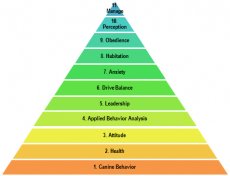Self help dog training

The correct term for training one's own service dog or one for an immediate member of your family is "owner training" because the dog is being trained by the owner instead of by a professional trainer or service dog program. "Self-training" is incorrect, because the dog is not training himself. Dogs start out as "service dog candidates" or "puppy candidates" while they are doing socialization and learning core obedience skills. They become "service dogs in training" (SDiT) when they are ready to begin learning the special behaviors that mitigate their owner/handler's disability. A dog learning to heel is not learning to be a service dog (he is a candidate). A dog learning to retrieve dropped objects is learning a service dog task or work (he is an SDiT). Within the online disability community, a service dog might be referred to as an "SD."
A very very rough guideline is that dogs under 6 months are typically candidates, still learning the basic core skills. Somewhere between 6 and 12 months, most owner-trainers will start working more on the specific skills that will mitigate their disabilities. The dog's maturity is a huge factor. A puppy under one year of age is not mentally or emotionally up to the challenge of shouldering the full responsibilities of a service dog and pushing them into that position is very highly likely to burn them out so that they don't want to be a service dog when they get older. Eagerness to learn is not the same thing as maturity. A puppy can be taught anything he is interested in doing at any age (even before weaning), but should not be made responsible to do those behaviors under pressure (in public) until he is at least 12 months old and then only in short bursts. Most owner-trainers will transition their candidate to the status of "service dog in training" somewhere between 6 and 12 months and start working on some light weight public access work to solidify core obedience skills and begin task training. It should be 100% fun fun fun with no responsibility until he is at least 12 months old. The transition from candidate to service dog in training should not be made before 6 months or before the puppy has passed a CGC (Canine Good Citizen) test and has learned at least one task. He should be at least 18 months old and have been doing public access training (performing his already mastered skills and tasks) in public for at least six months reliably before being transitioned from "service dog in training" to full service dog. Using correct terminology encourages people to take you seriously and signals to others in the service dog community that you are both knowledgeable about what you are doing and legitimate.
The Americans with Disabilities Act does not give people who are TRAINING service dogs any access rights. The ADA does not come into play until the dog is trained (meets the ADA definition). SOME states give trainers of service dogs some or all the same access rights as people with disabilities accompanied by fully trained service dogs. Not all states do. Among those that do, most do not include coverage for owner-trainers. Check the laws of your state very carefully. If you need help teasing out the relevant portions and interpreting them, post in the forum. Lots of people there have experience finding and deciphering state laws.
If your state does not give you access rights to train, you can still train in public. What you have to do is contact the business you would like to visit and politely explain your situation and ask for permission to train in their building. Many businesses either permit pets or will give permission for people training dogs to use their facilities. Good ones to try include pet stores, farm supply stores, home improvement stores, and small locally owned stores. Do not be angry if they say, "no." Just try again with another store. Businesses selling food will generally not be permitted to allow you to train even if they'd like to, because of state and local health codes.
Related posts:

 Training your dog to do advanced tricks like finding something or bringing their food bowl can be done with just 10 minutes a day and some clicker training. It’s…
Training your dog to do advanced tricks like finding something or bringing their food bowl can be done with just 10 minutes a day and some clicker training. It’s… MARY ISENHOUR-LONG Owner - Trainer Photo by Stewart Event Images About The Trainer The phrase, “gone to the dogs”, is certainly an appropriate one to describe my…
MARY ISENHOUR-LONG Owner - Trainer Photo by Stewart Event Images About The Trainer The phrase, “gone to the dogs”, is certainly an appropriate one to describe my… 6 Principles of Successful Training 1. Be Consistent: Apply the same rules and the same words all the time. 2. Be Concise: Give your command just once. Repetition…
6 Principles of Successful Training 1. Be Consistent: Apply the same rules and the same words all the time. 2. Be Concise: Give your command just once. Repetition… Cesar Millan Cesar is a best-selling author, public speaker, and internationally acclaimed star of the TV shows “Dog Whisperer with Cesar Millan, ” “Leader of the…
Cesar Millan Cesar is a best-selling author, public speaker, and internationally acclaimed star of the TV shows “Dog Whisperer with Cesar Millan, ” “Leader of the… At Monument Dog Training, we believe that change is always possible . We regularly resolve aggressive behavioral issues, even with dogs who have been written off…
At Monument Dog Training, we believe that change is always possible . We regularly resolve aggressive behavioral issues, even with dogs who have been written off…